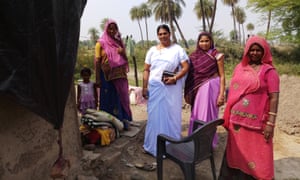It’s 10am and time for the first home visit of the day. After consulting a colour-coded map on the wall of the village centre, the three female health workers make their way through the winding lanes of a remote village in Jhalawar district, Rajasthan, where the rice has been harvested and garlic is being planted, to the home of Nirmala.
![]()
The yellow bindi (dot) on the map indicates that Nirmala and her children are highly likely to become malnourished without the proper care, which means the family is a priority for health services.
The three women tell Nirmala how important it is to breastfeed her newborn daughter, as she rocks her in a hammock made from a sari strung from the roof of her shack. Then they explain the importance of eating well and that her 18-month-old daughter must continue to receive extra food rations; she weighed only 1kg (2.2lbs) when she was born. Finally, they tell Nirmala the date of her next immunisation.
All this information has been loaded onto a tablet and is easily accessible to health workers via an app. It’s a smooth process, but it wasn’t always so.
Four years ago, Lata Nayar, an auxiliary nurse midwife, Vimla Gochar, a nutrition adviser, and Manju Suman, a volunteer trained in maternal and child health, worked separately. They didn’t share data about high-risk women and children and each reported to a different department and recorded their own information in the columns of bulky registers.
As a result, vulnerable women and children fell through the cracks. High-risk pregnancies were not monitored. Underweight children who were entitled to extra food rations failed to get them because they hadn’t been identified.
Today, however, all the data is compiled in one place and is easily accessed by the health workers on an app. All three women are aware in real time of any changes and updates, and all can take action to address or prevent problems, reducing maternal and child deaths.
Launched in Jhalawar, in Rajasthan state, by the Antara Foundation in 2015, the integrated programme, known as Akshada, focuses on the crucial 1,000 days between conception and the second year in a child’s life.
“They [the women] used to start in one area of the village and work sequentially, going from one house to another rather than first visiting the women and children who are most at risk. That meant delays. The key to reducing mortality is to identify the women and children and reach them fast,” says Ashok Alexander, founder of the Antara Foundation.
